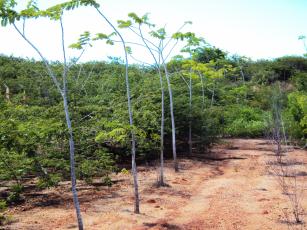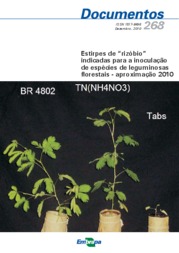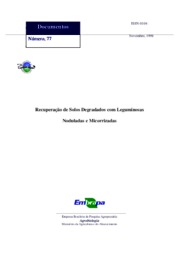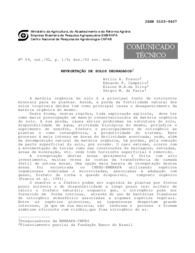Embrapa Agrobiology
 Busca de Produtos e Serviços
Busca de Produtos e Serviços
Recovery of degraded areas using nitrogen fixing leguminous forest plants associated with mycorrhizal fungi
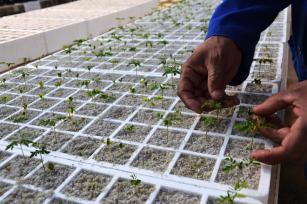
Photo: PORPINO, Gustavo
The degradation of the environment occurs worldwide and, in many cases, it is of great impact, reducing or eliminating the soil's fertile layer, organic matter content and subsoil exposure. Since the 1980s, Embrapa Agrobiology has developed techniques to recover the environmental component of areas that have suffered different levels of degradation, as a result of bad use of agricultural lands, disordered urban sprawl and overexploration of natural resources. The techniques for the recovery of such areas are mainly based on the selection and introduction of leguminous trees and bushes that can grow under adverse conditions. The success stems from the plant-rhizobium-fungus association, which allows for fast plant growth regardless of the nitrogen available in the soil. There is an increase in the organic matter content and in biological activity through the input of plant material, via plant litter. When associated with rhizobia, the legumes increase the efficiency of the process of fixing nitrogen from the air. The inoculants for forest legumes developed by Embrapa Agrobiology are produced with bacteria strains recommended for inoculation in plants used for the recovery of degraded areas. Inoculated seedlings generate vigorous plants that are tolerant to several types of stress, promoting their establishment and the occupation of the area to be rehabilitated. It is possible to obtain soil cover fast, which allows other plants species that are more demanding in terms of nutrients, shade, moisture, etc to appear. With the recovery of the vegetation, the animals return and previously existing biological processes are reactivated.
Embrapa has studies biological nitrogen fixation in legumes and non-legumes for over 25 years and selected several diazotrophic nitrogen fixing bacteria species, which can be used to produce inoculants for plants of agricultural and forestry importance. Such biological inputs can totally or partially supply the crops' nitrogen needs. Atmospheric nitrogen is captured by the bacteria and converted into a form that the plants can assimilate. In exchange, bacteria receive the carbon that is fixed by plant photosyntheses.
Who benefits from it
The technology has been used in different regions of Brazil to contain hillsides, reducing the risk of landslides in rainy periods, in urban areas, and for the recovery of areas degraded by mining or severe soil erosion.
Economic and environmental benefits
The adoption of the technology of N2 fixing legumes associated with mycorrhizal fungi in the recovery of degraded areas reduces or eliminates the use of nitrogen fertilizers, recovers the soil's production capacity and recomposes native forests, especially in enterprises aimed at mining activities. This way, they allow the optimization and reduction of the use of fertilizers and other agricultural inputs, reducing the costs of the process and increasing environmental gains.
The technology can be used in reforestation, recovery of degraded pastures, recovery of erosions and degraded hillsides, development of agroforestry systems and recovery of areas degraded by mining.
Where to find:
Links para publicações:
https://ainfo.cnptia.embrapa.br/digital/bitstream/CNPAB-2010/27134/1/cot009.pdf
https://ainfo.cnptia.embrapa.br/digital/bitstream/CNPAB-2010/27285/1/doc077.pdf
Link para mais informações:
https://www.embrapa.br/busca-de-solucoes-tecnologicas/-/produto-servico/88/recuperacao-de-areas-degradadas-usando-leguminosas-florestais-fixadoras-de-nitrogenio-associadas-a-fungos-micorrizicos
Link para projeto:
https://www.embrapa.br/busca-de-projetos/-/projeto/12786/recuperacao-de-areas-alteradas-por-atividades-de-mineracao-utilizando-especies-vegetais-nativas-que-se-associam-com-bacterias-fixadoras-de-nitrogenio-e-fungos-micorrizicos
Embrapa Agrobiologia
Rodovia BR-465, Km 7
Bairro Ecologia, Seropédica/RJ
Fone: (21) 3441-1500
Product: Inoculant Launch year: 1992
Responsible Unit: Embrapa Agrobiology
Participating Units: Embrapa Agrobiology
Keywords: Página Grandes Contribuições

